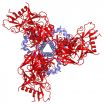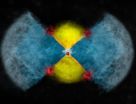(Press-News.org) A new study from UCLA found that a drug being evaluated to treat an entirely different disorder helped slow the progression of Parkinson's disease in mice.
The study, published in the October edition of the journal Neurotherapeutics, found that the drug, AT2101, which has also been studied for Gaucher disease, improved motor function, stopped inflammation in the brain and reduced levels of alpha-synuclein, a protein critically involved in Parkinson's.
Although the exact cause of Parkinson's is unknown, evidence points to an accumulation of alpha-synuclein, which has been found to be common to all people with the disorder. The protein is thought to destroy the neurons in the brain that make dopamine, a neurotransmitter that helps regulate a number of functions, including movement and coordination. Dopamine deficiency is associated with Parkinson's disease.
Gaucher disease is a rare genetic disorder in which the body cannot produce enough of an enzyme called β-glucocerebrosidase, or GCase. Researchers seeking genetic factors that increase people's risk for developing Parkinson's have determined that there may be a close relationship between Gaucher and Parkinson's due to a GCase gene. Mutation of this gene, which leads to decreased GCase activity in the brain, has been found to be a genetic risk factor for Parkinson's, although the majority of patients with Parkinson's do not carry mutations in the Gaucher gene.
"This is the first time a compound targeting Gaucher disease has been tested in a mouse model of Parkinson's disease and was shown to be effective," said the study's senior author, Marie-Francoise Chesselet, the Charles H. Markham Professor of Neurology at UCLA and director of the UCLA Center for the Study of Parkinson's Disease. "The promising findings in this study suggest that further investigation of this compound in Parkinson's disease is warranted."
In the study, the researchers used mice that were genetically engineered to make too much alpha-synuclein which, over time, led the animals to develop deficits similar to those observed in humans with Parkinson's. The researchers found that the mice's symptoms improved after they received AT2101 for four months.
The researchers also observed that AT2101 was effective in treating Parkinson's in mice even though they did not carry a mutant version of the Gaucher gene, suggesting that the compound may have a clinical effect in the broader Parkinson's population.
AT2101 is a first-generation "pharmacological chaperone" — a drug that can bind malfunctioning, mutated enzymes and lead them through the cell to their normal location, which allows the enzymes to carry on with their normal work. This was the first time that a pharmacological chaperone showed promise in a model of Parkinson's, according to Chesselet.
Parkinson's disease affects as many as 1 million Americans, and 60,000 new cases are diagnosed each year. The disorder continues to puzzle scientists. There is no cure and researchers have been unable to pin down its cause and no drug has been proven to stop the progression of the disease, which causes tremors, stiffness and other debilitating symptoms. Current Parkinson's treatments only address its symptoms.
INFORMATION:
The research was supported by Amicus Therapeutics, the UCLA Morris K. Udall Parkinson's Disease Research Center of Excellence (NIH grant NS-P50 NS38367), and gifts to the UCLA Center for the Study of Parkinson's Disease. A complete list of authors and additional disclosures are available in the manuscript.
The Center for the Study of Parkinson's Disease is part of the UCLA Department of Neurology, which encompasses more than 26 disease-related research programs.
Astronomers working with NASA's Nuclear Spectroscopic Telescope Array (NuSTAR), led by Caltech's Fiona Harrison, have found a pulsating dead star beaming with the energy of about 10 million suns. The object, previously thought to be a black hole because it is so powerful, is in fact a pulsar—the incredibly dense rotating remains of a star.
"This compact little stellar remnant is a real powerhouse. We've never seen anything quite like it," says Harrison, NuSTAR's principal investigator and the Benjamin M. Rosen Professor of Physics at Caltech. "We all thought an ...
ATLANTA – October 08, 2014 – A study from American Cancer Society researchers finds the increased risk of premature death associated with a higher body mass index (BMI) is similar for African Americans and whites, in contrast to previous, smaller studies that indicated the association may be weaker for African Americans. The study, published in the open-access, online publication PLOS ONE, finds that among never smokers without prevalent disease, overweight and obesity are strongly associated with subsequent risk of mortality in every race. The authors say ...
New Haven, Conn. - HIV is adept at eluding immune system responses because the protein it uses to infect cells is constantly changing.
Now a team of researchers including scientists from Yale have stripped the cloak from this master of disguise, providing a high resolution image of this surface spike protein and monitoring how it constantly changes its shape, information that suggests new ways to attack the virus through drugs and vaccines.
In two papers published simultaneously online Oct. 8 in the journals Science and Nature. team of researchers led by scientists ...
Highly-detailed radio-telescope images have pinpointed the locations where a stellar explosion called a nova emitted gamma rays, the most energetic form of electromagnetic waves. The discovery revealed a probable mechanism for the gamma-ray emissions, which mystified astronomers when first observed in 2012.
"We not only found where the gamma rays came from, but also got a look at a previously-unseen scenario that may be common in other nova explosions," said Laura Chomiuk, of Michigan State University.
A nova occurs when a dense white dwarf star pulls material onto ...
New research has illuminated the movement and complete structure of the spikes on HIV that the virus uses to bind to the cells it infects. This research, led by scientists at the National Institutes of Health, Weill Cornell Medical College and Yale University School of Medicine, could help advance efforts to develop HIV vaccines and treatments.
Three sets of a pair of molecules called gp120 and gp41 constitute each HIV spike, which adopts different configurations before and after the virus fuses with a cell. The atomic-level structures of pre-fusion gp120 and post-fusion ...
NEW YORK — (October 8, 2014) -- Researchers at Weill Cornell Medical College have developed technologies that allow investigators, for the first time, to watch what they call the "dance" of HIV proteins on the virus' surface, which may contribute to how it infects human immune cells. Their discovery is described in the Oct. 8 issue of Science, and is also a part of a study published the same day in Nature.
The new technology platform opens new possibilities for devising an approach to prevent HIV infection, says Dr. Scott Blanchard, an associate professor of physiology ...
Astronomers have discovered a black hole that is consuming gas from a nearby star 10 times faster than previously thought possible. The black hole—known as P13—lies on the outskirts of the galaxy NGC7793 about 12 million light years from Earth and is ingesting a weight equivalent to 100 billion billion hot dogs every minute.
The discovery was published today in the journal Nature.
International Centre for Radio Astronomy Research astronomer Dr Roberto Soria, who is based at ICRAR's Curtin University node, said that as gas falls towards a black hole it gets ...
An international team of astronomers has been able to see into the heart of an exploding star, by combining data from telescopes that are hundreds or even thousands of kilometres apart. Their results are published at 18:00 hours on Oct 8 2014 in the journal Nature.
Highly-detailed images produced using radio telescopes from across Europe and America have pinpointed the locations where a stellar explosion (called a nova), emitted gamma rays (extremely high energy radiation). The discovery revealed how the gamma-ray emissions are produced, something which mystified astronomers ...
This news release is available in German. A team of ETH Zurich researchers led by professors Nenad Ban and Ruedi Aebersold have studied the highly complex molecular structure of mitoribosomes, which are the ribosomes of mitochondria. Ribosomes are found in the cells of all living organisms. However, higher organisms (eukaryotes), which include fungi, plants, animals and humans, contain much more complex ribosomes than bacteria. In eukaryotes, ribosomes can also be divided into two types: those in the cytosol – which comprises the majority of the cell – and ...
(PHILADELPHIA) – Transfer RNAs (tRNAs) are ancient workhorse molecules and part of the cellular process that creates the proteins, critical building blocks of life that keep a cell running smoothly. A new discovery suggests that the number of human genomic loci that might be coding for tRNAs is nearly double what is currently known. Most of the newly identified loci resemble the sequences of mitochondrial tRNAs suggesting unexpected new links between the human nuclear and mitochondrial genomes, links that are not currently understood.
Transfer RNAs (tRNAs) represent ...



